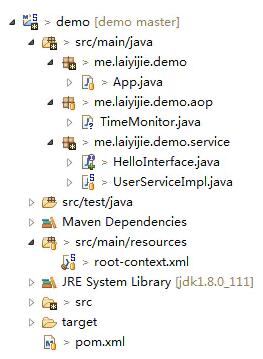Spring AOP 切面@Around注解的用法說明
@Around注解可以用來在調(diào)用一個具體方法前和調(diào)用后來完成一些具體的任務。
比如我們想在執(zhí)行controller中方法前打印出請求參數(shù),并在方法執(zhí)行結(jié)束后來打印出響應值,這個時候,我們就可以借助于@Around注解來實現(xiàn);
再比如我們想在執(zhí)行方法時動態(tài)修改參數(shù)值等
類似功能的注解還有@Before等等,用到了Spring AOP切面思想,Spring AOP常用于攔截器、事務、日志、權(quán)限驗證等方面。
完整演示代碼如下:需要說明的是,在以下例子中,我們即可以只用@Around注解,并設置條件,見方法run1();也可以用@Pointcut和@Around聯(lián)合注解,見方法pointCut2()和run2(),這2種用法是等價的。如果我們還想利用其進行參數(shù)的修改,則調(diào)用時必須用joinPoint.proceed(Object[] args)方法,將修改后的參數(shù)進行回傳。如果用joinPoint.proceed()方法,則修改后的參數(shù)并不會真正被使用。
import org.aspectj.lang.ProceedingJoinPoint;import org.aspectj.lang.annotation.Around;import org.aspectj.lang.annotation.Aspect;import org.aspectj.lang.annotation.Pointcut;import org.aspectj.lang.reflect.MethodSignature;import org.slf4j.Logger;import org.slf4j.LoggerFactory;import org.springframework.beans.factory.annotation.Autowired;import org.springframework.stereotype.Component; import javax.persistence.EntityManager; /** * 控制器切面 * * @author lichuang */ @Component@Aspectpublic class ControllerAspect { private static final Logger logger = LoggerFactory.getLogger(ControllerAspect.class); @Autowired private EntityManager entityManager; /** * 調(diào)用controller包下的任意類的任意方法時均會調(diào)用此方法 */ @Around('execution(* com.company.controller.*.*(..))') public Object run1(ProceedingJoinPoint joinPoint) throws Throwable { //獲取方法參數(shù)值數(shù)組 Object[] args = joinPoint.getArgs(); //得到其方法簽名 MethodSignature methodSignature = (MethodSignature) joinPoint.getSignature(); //獲取方法參數(shù)類型數(shù)組 Class[] paramTypeArray = methodSignature.getParameterTypes(); if (EntityManager.class.isAssignableFrom(paramTypeArray[paramTypeArray.length - 1])) { //如果方法的參數(shù)列表最后一個參數(shù)是entityManager類型,則給其賦值 args[args.length - 1] = entityManager; } logger.info('請求參數(shù)為{}',args); //動態(tài)修改其參數(shù) //注意,如果調(diào)用joinPoint.proceed()方法,則修改的參數(shù)值不會生效,必須調(diào)用joinPoint.proceed(Object[] args) Object result = joinPoint.proceed(args); logger.info('響應結(jié)果為{}',result); //如果這里不返回result,則目標對象實際返回值會被置為null return result; } @Pointcut('execution(* com.company.controller.*.*(..))') public void pointCut2() {} @Around('pointCut2()') public Object run2(ProceedingJoinPoint joinPoint) throws Throwable { //獲取方法參數(shù)值數(shù)組 Object[] args = joinPoint.getArgs(); //得到其方法簽名 MethodSignature methodSignature = (MethodSignature) joinPoint.getSignature(); //獲取方法參數(shù)類型數(shù)組 Class[] paramTypeArray = methodSignature.getParameterTypes(); if (EntityManager.class.isAssignableFrom(paramTypeArray[paramTypeArray.length - 1])) { //如果方法的參數(shù)列表最后一個參數(shù)是entityManager類型,則給其賦值 args[args.length - 1] = entityManager; } logger.info('請求參數(shù)為{}',args); //動態(tài)修改其參數(shù) //注意,如果調(diào)用joinPoint.proceed()方法,則修改的參數(shù)值不會生效,必須調(diào)用joinPoint.proceed(Object[] args) Object result = joinPoint.proceed(args); logger.info('響應結(jié)果為{}',result); //如果這里不返回result,則目標對象實際返回值會被置為null return result; }}
補充:Spring Aop實例(AOP 如此簡單)@Aspect、@Around 注解方式配置
IoC相關的基本內(nèi)容告一段落,本次介紹Spring的第二個特性,AOP,面向切面編程,術語聽起來比較不容易理解,沒關系,一切盡在實例中,讓我們看一個簡單的實例,就能明白。
實例項目工程目錄結(jié)構(gòu)和代碼獲取地址
獲取地址(版本Log將會注明每一個版本對應的課程)
https://github.com/laiyijie/SpringLearning
目錄結(jié)構(gòu)
運行具有Main函數(shù)的 App.java
得到如下輸出
method start time:1480223298250userHellomethod end time:1480223299250項目詳解
從App.java入手
App.java
package me.laiyijie.demo;import org.springframework.context.support.ClassPathXmlApplicationContext;import me.laiyijie.demo.service.HelloInterface;public class App { public static void main(String[] args) { ClassPathXmlApplicationContext context = new ClassPathXmlApplicationContext('root-context.xml'); HelloInterface userService = context.getBean(HelloInterface.class); userService.sayHello(); context.close(); }}
調(diào)用的是HelloInterface的sayHello方法
HelloInterface.java
package me.laiyijie.demo.service;public interface HelloInterface{ void sayHello(); }
其實現(xiàn)類為UserServiceImpl.java
UserServiceImpl.java
package me.laiyijie.demo.service;import org.springframework.stereotype.Service;@Servicepublic class UserServiceImpl implements HelloInterface { public void sayHello() { try { Thread.sleep(1000); } catch (InterruptedException e) { // TODO Auto-generated catch block e.printStackTrace(); } System.out.println('userHello'); } }
誒?情況跟我們看到的代碼有出入?
sayHello 應該只輸出 userHello,前后兩行輸出從何出現(xiàn)?
在Main函數(shù)中找不到一點兒線索!
這就是AOP的一個強大特性:
無侵入性,不改變原有的代碼,卻能增加功能!
那么究竟是如何增加功能的呢?
讓我們看看TimeMonitor.java
TimeMonitor.java
package me.laiyijie.demo.aop;import org.aspectj.lang.ProceedingJoinPoint;import org.aspectj.lang.annotation.Around;import org.aspectj.lang.annotation.Aspect;import org.springframework.stereotype.Service;@Service@Aspectpublic class TimeMonitor { @Around('execution(* me.laiyijie.demo.service.UserServiceImpl.sayHello(..))') public void monitorAround(ProceedingJoinPoint pjp) throws Throwable { System.out.println('method start time:' + System.currentTimeMillis()); Object re = pjp.proceed(); System.out.println('method end time:' + System.currentTimeMillis()); }}
終于看到了 method start time:1480223298250 和 method end time:1480223299250這兩行輸出是從哪兒出現(xiàn)的了!
讓我們來仔細解讀一下這個類
類有兩個注釋,分別是@Service和@Aspect,第一個注解是使得TimeMonitor受Spring托管并實例化。@Aspect就是使得這個類具有AOP功能(你可以這樣理解)兩個注解缺一不可
類里面只有一個方法,名字叫做monitorAroud,其實就是為了檢測函數(shù)執(zhí)行時間的!
那么關鍵點來了,兩個輸出語句是怎么插入到sayHello方法的前后的呢!
看這個注解:
@Around('execution(* me.laiyijie.demo.service.UserServiceImpl.sayHello(..))')
@Around表示包圍一個函數(shù),也就是可以在函數(shù)執(zhí)行前做一些事情,也可以在函數(shù)執(zhí)行后做一些事情
execution(* me.laiyijie.demo.service.UserServiceImpl.sayHello(..))
這個比較好理解,就是使用表達式的方式指定了要對哪個函數(shù)進行包圍!(除了execution以外還有很多,可以搜索AspectJ語法來學習)
也就是說,這個注解完整的說明了,應該在函數(shù)的什么位置插入變化,也就是所謂的切點
之后是函數(shù)的定義:
public Object monitorAround(ProceedingJoinPoint pjp)
這里引入了ProceedingJoinPoint,在使用了@Around之后可以帶入這個參數(shù),代表的其實就是sayHello這個函數(shù),不過做了一些封裝
而 Object re = pjp.proceed(); 就是相當于執(zhí)行了 sayHello方法!
剩下的代碼就不用過多解釋了,就是在執(zhí)行這個函數(shù)的前后分別進行了系統(tǒng)時間的獲取。
我們把這個函數(shù)體,也就是定義了要做那些事情的代碼,稱作增強
而包含切點和增強結(jié)合起來就稱作切面
面向切面由此而來!
Spring AOP 開啟需要的配置需要配置兩項
1、pom.xml增加依賴(因為要用到AOP還需要不同的JAR包)
2、root-context.xml中增加切面相關配置
root-context.xml
<?xml version='1.0' encoding='UTF-8'?><beans xmlns='http://www.springframework.org/schema/beans' xmlns:xsi='http://www.w3.org/2001/XMLSchema-instance' xmlns:context='http://www.springframework.org/schema/context' xmlns:aop='http://www.springframework.org/schema/aop' xsi:schemaLocation='http://www.springframework.org/schema/beans http://www.springframework.org/schema/beans/spring-beans.xsd http://www.springframework.org/schema/context http://www.springframework.org/schema/context/spring-context-4.3.xsd http://www.springframework.org/schema/aop http://www.springframework.org/schema/aop/spring-aop-4.3.xsd'> <aop:aspectj-autoproxy></aop:aspectj-autoproxy> <context:component-scan base-package='me.laiyijie.demo'></context:component-scan></beans>
root-context.xml 增加了兩行
1、xmlns:aop='http://www.springframework.org/schema/aop'
代表加入命名空間
2、<aop:aspectj-autoproxy></aop:aspectj-autoproxy>
使用1中引入的aop命名空間開起自動代理(自動代理具體含義后續(xù)慢慢解釋,簡單的理解就是AOP的實現(xiàn)是依靠自動代理實現(xiàn)的)
pom.xml
<project xmlns='http://maven.apache.org/POM/4.0.0' xmlns:xsi='http://www.w3.org/2001/XMLSchema-instance' xsi:schemaLocation='http://maven.apache.org/POM/4.0.0 http://maven.apache.org/xsd/maven-4.0.0.xsd'> <modelVersion>4.0.0</modelVersion> <groupId>me.laiyijie</groupId> <artifactId>demo</artifactId> <version>0.0.1-SNAPSHOT</version> <packaging>jar</packaging> <dependencies> <!-- https://mvnrepository.com/artifact/org.springframework/spring-context --> <dependency> <groupId>org.springframework</groupId> <artifactId>spring-context</artifactId> <version>4.3.2.RELEASE</version> </dependency> <!-- https://mvnrepository.com/artifact/org.aspectj/aspectjweaver --> <dependency> <groupId>org.aspectj</groupId> <artifactId>aspectjweaver</artifactId> <version>1.8.9</version> </dependency> </dependencies></project>
增加了一個依賴
AspectJ 一個強大的AOP框架,也就是@Aspect和@Around以及ProceedingJoinPoint這些注解和方法的提供者
小結(jié)增強:定義了應該怎么把額外的動作加入到指定函數(shù)中
切點:定義了你應該把增強插入到哪個函數(shù)的什么位置
切面:切點和增強組合起來的稱呼
以上為個人經(jīng)驗,希望能給大家一個參考,也希望大家多多支持好吧啦網(wǎng)。如有錯誤或未考慮完全的地方,望不吝賜教。
相關文章:

 網(wǎng)公網(wǎng)安備
網(wǎng)公網(wǎng)安備